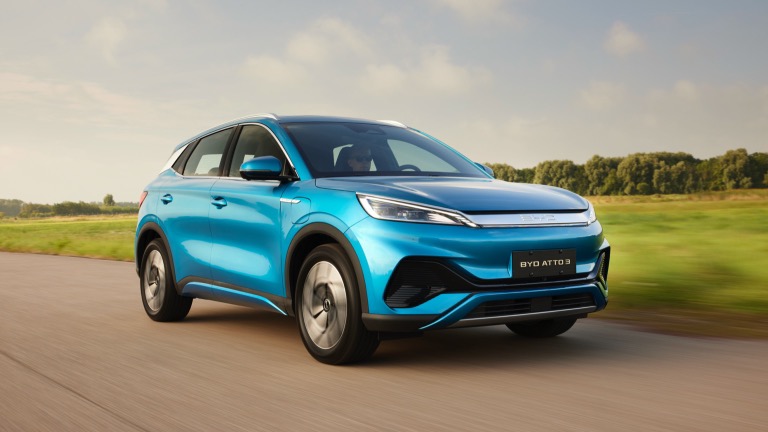
The BYD Atto 3 has become one of the most accessible electric SUVs on Australian roads. With WLTP range figures of roughly 345 km (standard/short‑range battery) and about 420 km (extended‑range battery), a rotating 12.8‑inch infotainment screen and a comprehensive suite of driver‑assist systems, the Atto 3 is aimed squarely at buyers seeking a practical, affordable EV. Charging behaviour is a key part of ownership, so this guide covers ports and plugs, charge speeds and times, running costs, home‑ and public‑charging tips, and compatibility notes relevant to Australian drivers.
Key specifications (high level)
- Battery usable: ~50 kWh (standard) / ~60 kWh (extended)
- WLTP range: ~345 km (standard) / ~420 km (extended)
- Efficiency (WLTP): ~144-145 Wh/km
- AC (onboard charger): single‑phase, nominally ~7 kW (commonly quoted 7.0-7.2 kW)
- DC fast charge: acceptance typically in the 70-88 kW region depending on model and conditions
Charging port, plug type and location
- The Atto 3 uses a CCS Combo 2 inlet (Type 2 top section for AC; combined DC/AC for CCS). This is the standard fitment across Europe and Australia and is what you’ll find at the major public networks.
- On Australian Atto 3s the inlet is on the front‑right fender (above the wheel arch). Positioning means you’ll generally want to approach AC/DC stalls with the car front‑right nearest the charger.
How and where to charge
- Home (AC): Use the supplied portable cable for occasional slow charging from a domestic power point. For regular home charging, a dedicated wall‑box (32 A single‑phase / ~7 kW) is strongly recommended – it makes overnight charging reliable and faster.
- Public AC: Most shopping‑centre and workplace AC chargers are Type 2 tethered or Type 2 sockets. You’ll plug in just as at home (but use the provider’s payment method or app if required).
- DC fast / rapid: Public rapid chargers use a tethered CCS connector – you simply plug the CCS into the Atto 3 and start the session via the station interface or provider app.
- Finding chargers: Use the Atto 3’s navigation which links to charger maps, or third‑party apps (PlugShare) and network apps (Chargefox, Evie Networks, etc.) to check real‑time availability and ratings.
Step‑by‑step for public charging
- Park so the charging inlet is nearest the stall; reverse in if necessary.
- Open the charging flap, unhook the connector from the holster and insert it firmly into the CCS inlet.
- Start the session via the charger’s screen, the network app, or an RFID card; the car and charger will communicate and charging will begin within a few seconds.
- Monitor status via the car’s instrument cluster, BYD app or the charger screen. End the session using the same interface and return the connector to the holster.
Charge speeds and times – what to expect
AC charging (Level 1 / Level 2)
- Onboard AC capacity is approximately 7 kW (single‑phase). Actual delivered power depends on the wallbox and wiring.
- Typical rates:
- Plugging into a standard 10 A domestic outlet (~2-2.4 kW) will add roughly 15-20 km of range per hour (varies with driving efficiency). A near‑empty to full charge can take longer than a day, so this is best for occasional or emergency use.
- Using a 32 A / ~7 kW wallbox will add around 40-60 km of range per hour and will usually fully charge the battery overnight (typical full charge from a low state of charge in ~6-9 hours, depending on battery size and starting SOC).
- Practical tip: Install a dedicated 32 A charger at home if you want daily full charges without lengthy wait times.
DC fast charging (Level 3)
- The Atto 3’s DC acceptance varies by variant and temperature; many Australian tests show peak acceptance broadly in the 70-88 kW window, with an average session power lower than the peak.
- Real‑world example: you can typically charge from around 10% to 80% in roughly 30-40 minutes at a suitably rated DC charger. Initial charge rates are highest from low SOC and then taper.
- Recommendation: For routine rapid charging, stopping at about 80% is sensible – it’s faster and gentler on the pack; reserve 100% for long trips where you need full range.
Costs – what you’ll pay to charge an Atto 3
Costs depend on electricity tariffs and charging network pricing. Using the Atto 3 Extended Range as a basis and a WLTP efficiency of ~144 Wh/km (0.144 kWh/km):
- Energy use ≈ 14.4 kWh per 100 km (0.144 kWh × 100 km).
- Examples:
- Home charging at $0.30/kWh ≈ $4.32 per 100 km (14.4 kWh × $0.30).
- Public DC fast charging at $0.60/kWh ≈ $8.64 per 100 km.
- If you pay $0.20/kWh at home, that falls to about $2.88/100 km; at $0.80/kWh rapid pricing it rises to about $11.52/100 km.
- Comparison to petrol: assuming a petrol car at ~7-8 L/100 km and fuel at $2.00/L, fuel costs are roughly $14-$16 per 100 km, so the Atto 3 typically remains cheaper to run per kilometre – especially when most charging is done at home.
Recommended charge levels and battery chemistry
- The Atto 3 uses an LFP (lithium iron phosphate) battery chemistry on many variants. LFP has higher cycle life and is more tolerant of repeated full charges than nickel‑based chemistries.
- BYD guidance and common practice for LFP packs: charging to 100% for daily use is acceptable and won’t cause the same accelerated degradation concerns as older chemistries. That said, repeated very high‑power DC sessions and sustained high SOCs at high temperatures are still worth avoiding when practical.
- Practical rule: For everyday use, charge to the level that suits your daily range needs (100% is generally fine for LFP). For frequent long fast‑charging sessions, try to manage SOC and limit unnecessary 100% fast charges.
Charging at home – what to install
- Compatible hardware: the Atto 3 works with the supplied portable cable, standard Type 2 wallboxes and most Australian home chargers.
- Recommended: a 32 A, single‑phase wallbox (7 kW) professionally installed, ideally on an off‑peak tariff or paired with home solar to lower running costs.
- Safety: always use a licensed electrician for wallbox installation and make sure your home supply and earthing meet Australian electrical standards.
Public DC networks and Tesla Supercharger compatibility
- The Atto 3 charges on the major CCS networks in Australia (Chargefox, Evie Networks and other providers).
- Tesla Superchargers: Tesla has progressively opened many of its Supercharger sites in Australia to non‑Tesla CCS vehicles. Compatibility varies by site, charger generation (V2, V3, V4) and vehicle model year. Some earlier Atto 3 model years have reported compatibility problems on very high‑power V3/V4 stalls; later BYD model updates and software revisions have improved compatibility.
- Using Tesla sites: non‑Tesla access is through the Tesla app – add payment, select “Charge your non‑Tesla” where available, and follow the on‑screen steps. Before relying on a particular Supercharger for a trip, check the Tesla app and owner‑community reports for the latest compatibility notes for Atto 3.
Vehicle‑to‑Load (V2L) and bidirectional charging
- The Atto 3 supports Vehicle‑to‑Load (V2L) via a supplied adapter that connects to the Type 2 AC port and provides about 2.2 kW continuous power – enough to run household appliances, power tools or small camping gear.
- V2L is convenient for outdoor use or as an emergency power source, but remember output is limited to roughly the adapter’s rating and prolonged use will deplete the vehicle battery.
Practical charging tips for Australian owners
- Precondition the battery before fast charging where possible (many EVs warm the pack when you set navigation to a DC charger) – this can raise peak acceptance and shorten times.
- Plan charging stops around a realistic average charging rate – networks and temperatures influence delivered power.
- Use home charging for most energy needs; reserve rapid DC for long trips or occasional top‑ups.
- When using public chargers, check plug tether length and alignment before you park to avoid tight cable pulls.
- Keep firmware and BYD app updated – charging compatibility and optimisation often improve with software updates.
Conclusion
The BYD Atto 3 is a pragmatic, affordable electric SUV for Australian drivers. Its CCS inlet, practical AC charging capability and respectable DC acceptance make it straightforward to integrate into everyday life, particularly if owners take advantage of home wallboxes and plan DC stops for longer journeys. The LFP chemistry gives owners flexibility to charge to 100% without the same concerns associated with nickel‑based batteries, while practical measures – preconditioning, smart charging schedules, and conservative use of rapid chargers – will maximise convenience and long‑term battery health. With the country’s charging networks expanding, Atto 3 owners who combine regular home charging with occasional rapid stops should find ownership economical and convenient.
FAQs
Q: How long does it take to charge a BYD Atto 3 at home?
A: With a dedicated 32 A (~7 kW) single‑phase wallbox expect a near‑empty battery to reach a full charge overnight – roughly 6-9 hours depending on battery size and starting SOC. Using a domestic 10 A outlet is much slower and may take more than a day for a full charge.
Q: How long to charge from 10% to 80% on a fast charger?
A: Typically around 30-40 minutes on a suitably powerful DC charger, though actual time depends on charger power, ambient temperature and battery temperature/condition.
Q: Can the Atto 3 use Tesla Superchargers in Australia?
A: Many Tesla Supercharger sites in Australia have been opened to non‑Tesla CCS vehicles via the Tesla app, but compatibility can vary by site and charger generation. Some early Atto 3 model years have reported issues on the highest‑power V3/V4 stalls. Check the Tesla app and community reports for the latest status before planning a trip.
Q: How much does it cost to charge per 100 km?
A: Using a WLTP consumption of about 14.4 kWh/100 km: at $0.30/kWh home charging costs roughly $4.32/100 km. Public DC prices are higher (eg. $0.50-$0.80/kWh), so costs can range from about $3-$12 per 100 km depending on your electricity price and charging method.
Q: Should I charge the Atto 3 to 100% every day?
A: The Atto 3 uses LFP chemistry, which is more tolerant of full SOCs; BYD and many owners consider charging to 100% acceptable for daily use. Still, avoid unnecessary high‑power fast charging to 100% if it can be avoided, and manage SOC for longevity if you frequently fast charge.
Q: Does the Atto 3 support V2L?
A: Yes. The Atto 3 includes a V2L adapter that can supply around 2.2 kW of AC power for appliances and outdoor use.
About EV Evolution
EV Evolution is the leading online platform dedicated to Australian electric vehicle owners and enthusiasts. We foster a vibrant community, delivering essential EV news and insights, and enhancing user engagement through our innovative, AI-powered chatbot for dynamic discussions. Our mission is to empower Australian electric vehicle owners and enthusiasts by fostering a vibrant, AI-driven online community that connects, informs, and advances the nation’s electric vehicle landscape.




